Flies
two—winged
The reputation of all flies is damaged by the penchant of that drab, noisy and obnoxious house fly to sully house and food. This is unfortunate for outdoors we have many unthreatening, colourful, and delightful types of flies—everything from the hover flies to the tiny condylostylid fly.
Particularly fun to watch are hover flies. Also known as flower flies, the many species are important pollinators. Probably to protect themselves from birds as they travel from flower to flower, many mimic either bees or wasps—a bluff, as they neither sting nor bite.
However, many of the bugs which are called flies, aren’t. Or at least aren’t true flies—the ones with only two wings. Indeed, the scientific name for this order is Diptera, literally from the Greek: di meaning two, and pteron meaning wing. What would have been the second pair of wings has shrunk to become the halteres, devices which vibrate rapidly and serve as gyroscopes for detecting changes in direction.
The halteres on diptera evolved from the hind wings and take the form of short appendages ending in a knob. They are usually difficult to spot, for when the fly is resting, the wings cover them—an exception is the crane fly, which rests with its wings spread.
Many species of flies show a sexual difference in the eyes with the male having the larger eyes which nearly touch in the middle and the female having the smaller eyes separated by a broad frontal stripe. Examples of both sexes are readily apparent in many of the pictures, below.
The widespread house fly is a true fly; the dragonfly is not. An etymological clue to the entomology is found in their names: true flies are (generally) written as two words—hover fly; others are written as one word—butterfly. So, the following are not true flies: mayflies, dragonflies, damselflies, stoneflies, whitefly, fireflies, alderflies, dobsonflies, snakeflies, sawflies, caddisflies, butterflies.
Until confirmed by an entomologist, the identification of any of the beasties, below, should be viewed as tentative.
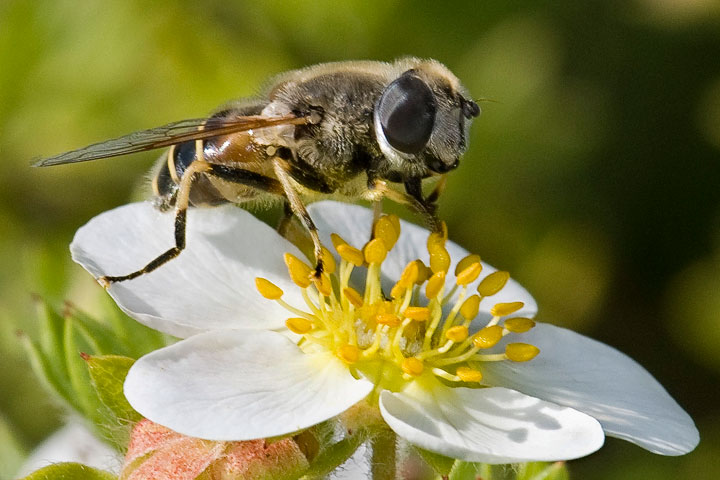 Hover fly are mimics— they protect themselves by pretending to be a bee or wasp. They are, however, named for their unusual ability to hover. This is a hourglass hover fly (Eristalis arbustorum), which mimics a bee: that it is really a fly can be seen from the short antennae, the eyes, the legs, and the fatter abdomen. Hover flies visit flowers. The knob of a haltere can be seen on this fly: the tiny sphere below the forewing and above the foreleg.
Hover fly are mimics— they protect themselves by pretending to be a bee or wasp. They are, however, named for their unusual ability to hover. This is a hourglass hover fly (Eristalis arbustorum), which mimics a bee: that it is really a fly can be seen from the short antennae, the eyes, the legs, and the fatter abdomen. Hover flies visit flowers. The knob of a haltere can be seen on this fly: the tiny sphere below the forewing and above the foreleg.
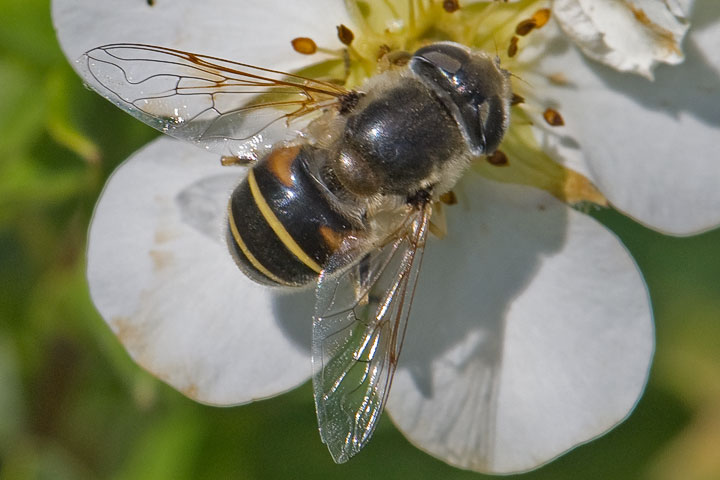 This is the same hourglass hover fly as seen above. It apparently gains its name from the black hourglass on the front of its abdomen.
This is the same hourglass hover fly as seen above. It apparently gains its name from the black hourglass on the front of its abdomen.
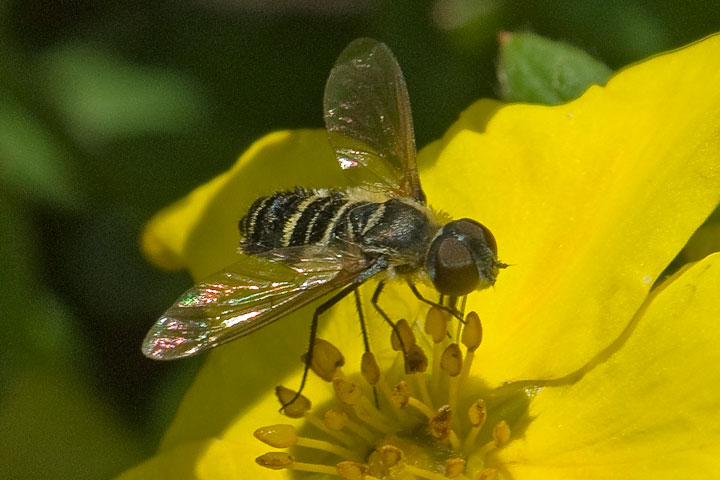 This is a bee fly (Bombyliidae Villa sp.), not a hover fly, but it is also a mimic.
This is a bee fly (Bombyliidae Villa sp.), not a hover fly, but it is also a mimic.
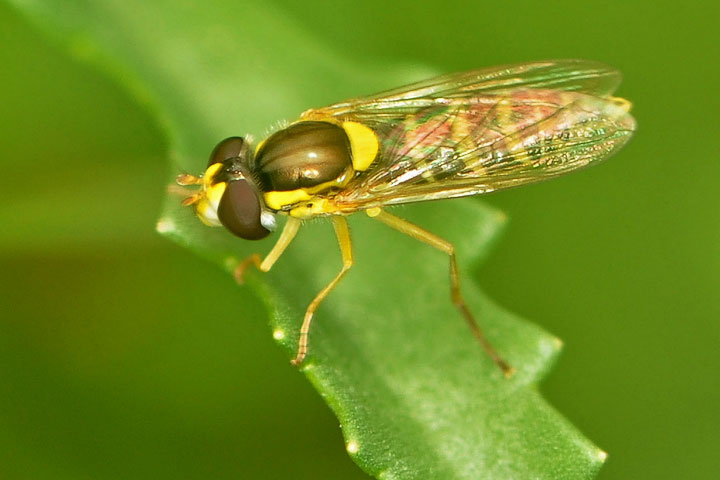 While many of the local hover flies mimic bees, this colourful little female (of unknown species) mimics a wasp. The sex of hover flies (and many other flies) is easy to determine by looking at the eyes: males have large eyes which almost touch in the middle, females have smaller more widely separated eyes.
While many of the local hover flies mimic bees, this colourful little female (of unknown species) mimics a wasp. The sex of hover flies (and many other flies) is easy to determine by looking at the eyes: males have large eyes which almost touch in the middle, females have smaller more widely separated eyes.
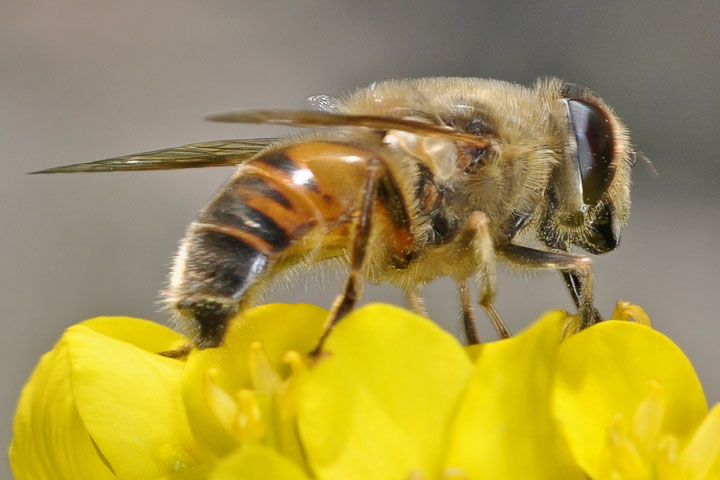 The drone fly is a hover fly which is so named because it mimics the honey bee drone.
The drone fly is a hover fly which is so named because it mimics the honey bee drone.
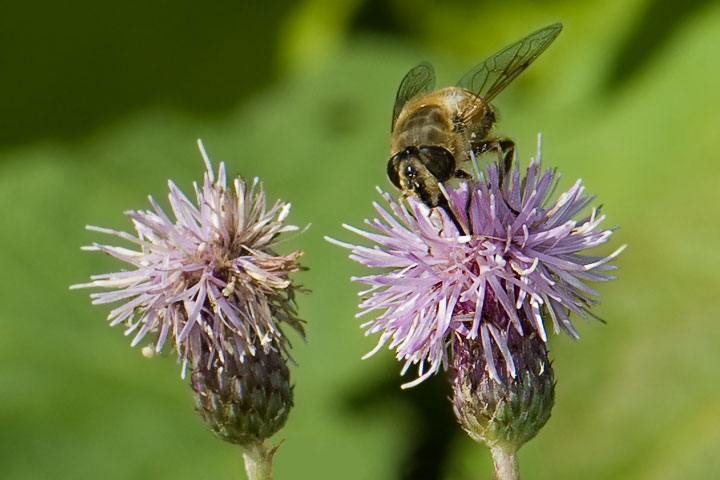 The drone fly visits flower, in this case a spotted knapweed.
The drone fly visits flower, in this case a spotted knapweed.
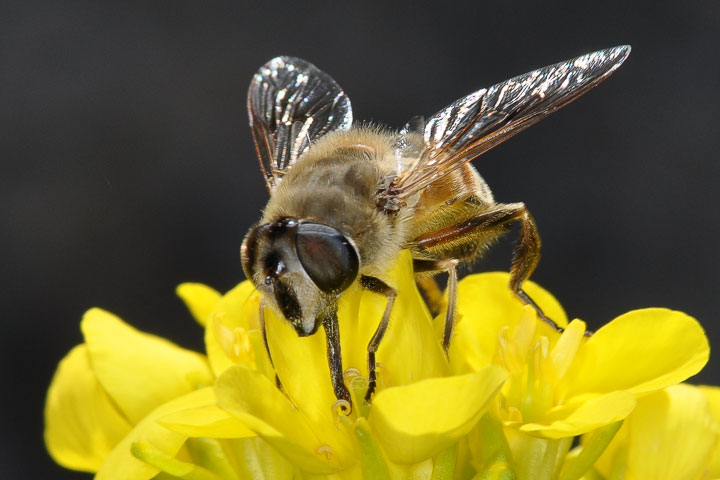 The widely spaced eyes reveal this drone fly (Eristalis tenax) to be female. The secondary wings have not shrunk to halteres, but are quite small.
The widely spaced eyes reveal this drone fly (Eristalis tenax) to be female. The secondary wings have not shrunk to halteres, but are quite small.
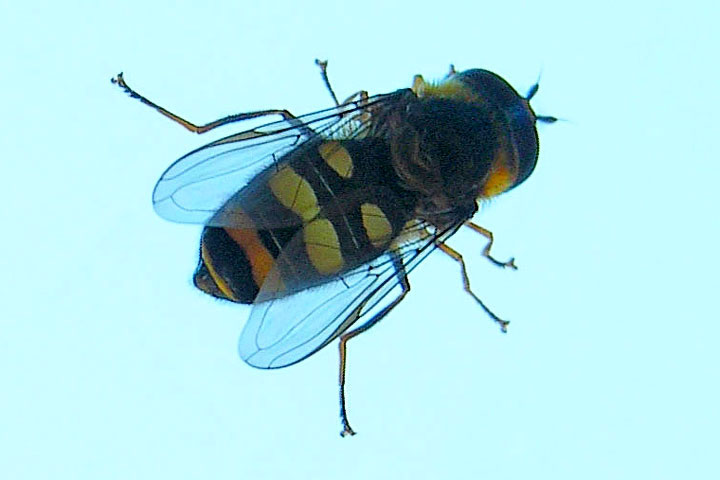 This pair of pictures shows two as–yet–unidentified species of hover flies.
This pair of pictures shows two as–yet–unidentified species of hover flies.
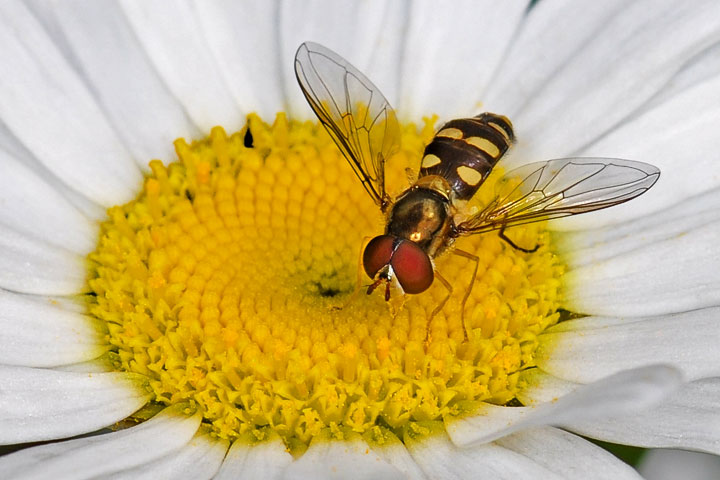 This pair of pictures shows two as–yet–unidentified species of hover flies.
This pair of pictures shows two as–yet–unidentified species of hover flies.
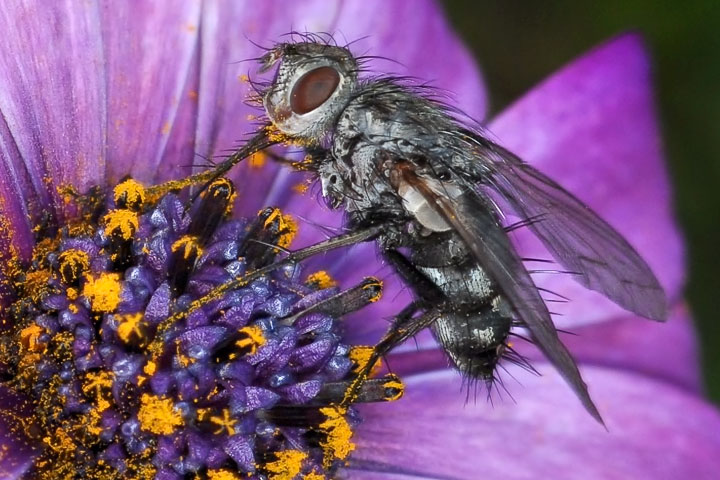 The long–tongue tachinid fly (Senostoma sp.) is, like all tachinids, covered in spiky hairs.
The long–tongue tachinid fly (Senostoma sp.) is, like all tachinids, covered in spiky hairs.
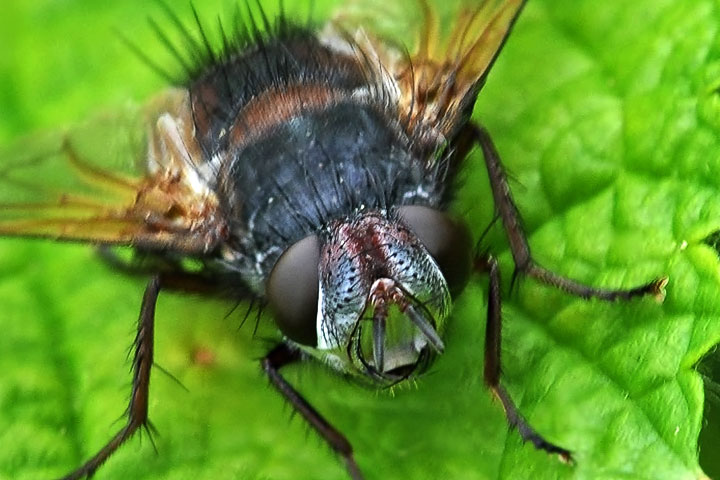 The widely spaced eyes of this tachinid fly (Tachinidae) suggests that it is a female. The larvae (maggots) of most members of this family are parasitoids—that is, they develop inside a living host, ultimately killing it.
The widely spaced eyes of this tachinid fly (Tachinidae) suggests that it is a female. The larvae (maggots) of most members of this family are parasitoids—that is, they develop inside a living host, ultimately killing it.
 The same long–tongue tachinid fly as above, but seen from above.
The same long–tongue tachinid fly as above, but seen from above.
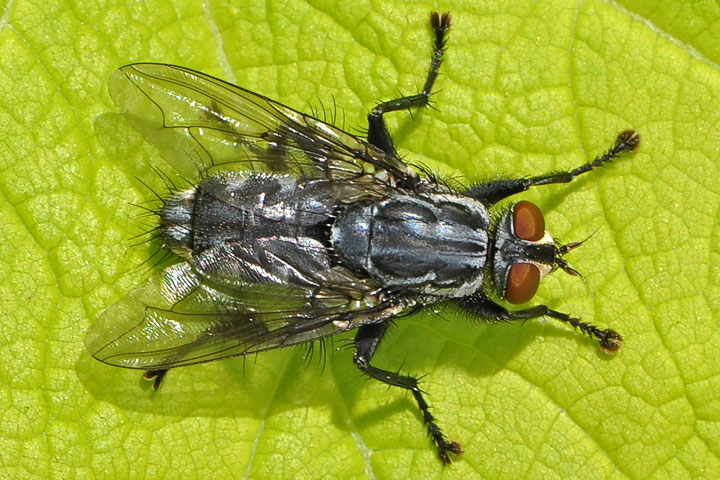 The flesh fly (Sarcophagidae) usually breeds in carrion, dung, or decaying material, but a few species lay their eggs in the open wounds of mammals. There larvae are commonly known as maggots.
The flesh fly (Sarcophagidae) usually breeds in carrion, dung, or decaying material, but a few species lay their eggs in the open wounds of mammals. There larvae are commonly known as maggots.
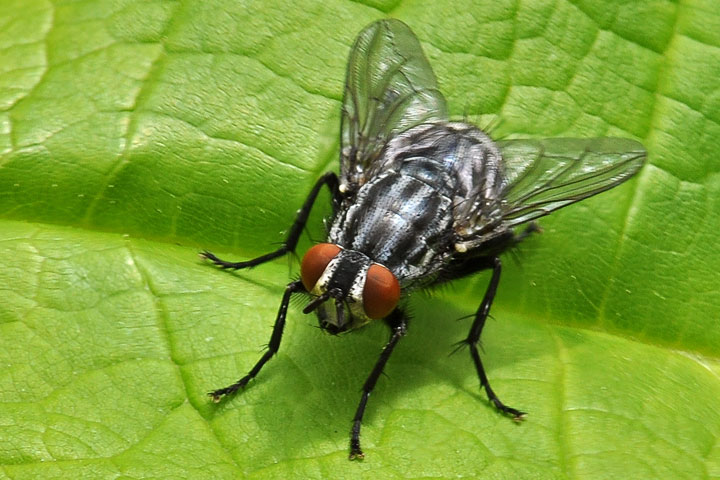 The same flesh fly as above, but seen from the front.
The same flesh fly as above, but seen from the front.
 The green bottle fly prefers to feast upon carrion.
The green bottle fly prefers to feast upon carrion.
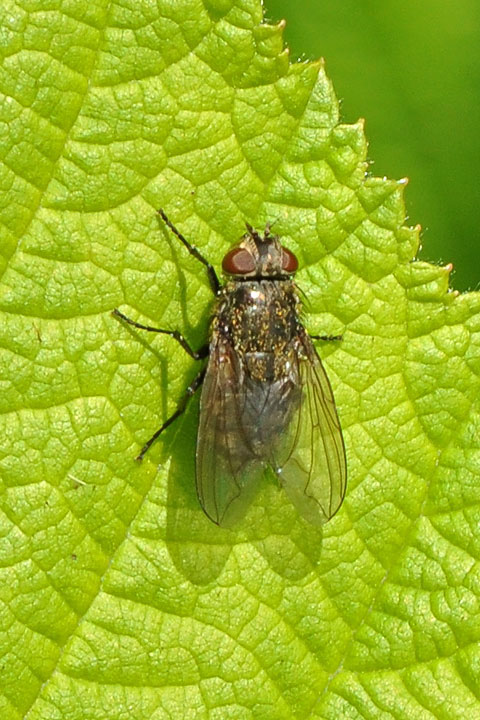 This pair of flies is probably the same species (likely Calliphoridae. Pollenia sp.). The one on the left, having smaller eyes, would be female; the one on the right, male. Pictures are not to the same scale.
This pair of flies is probably the same species (likely Calliphoridae. Pollenia sp.). The one on the left, having smaller eyes, would be female; the one on the right, male. Pictures are not to the same scale.
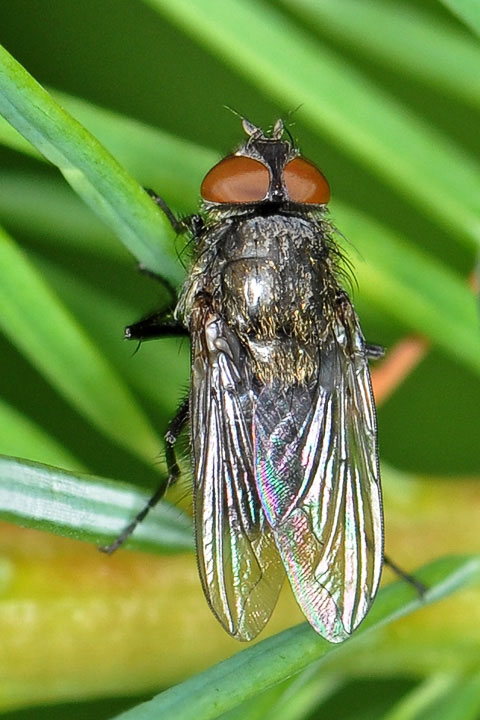 This pair of flies is probably the same species (likely Calliphoridae. Pollenia sp.). The one on the left, having smaller eyes, would be female; the one on the right, male. Pictures are not to the same scale.
This pair of flies is probably the same species (likely Calliphoridae. Pollenia sp.). The one on the left, having smaller eyes, would be female; the one on the right, male. Pictures are not to the same scale.
 This is a anthrax bee fly (Tribe Anthracini). These flies have partially clear, swept–back wings. They parasitize beetles and wasps.
This is a anthrax bee fly (Tribe Anthracini). These flies have partially clear, swept–back wings. They parasitize beetles and wasps.
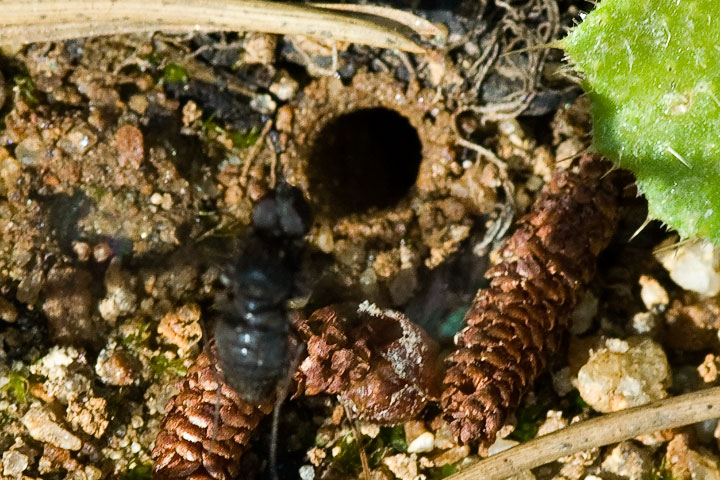 An anthrax bee fly scours the beach along the lakeshore for insects to parasitize. It is examining the entrance to (what is likely) a wasp burrow.
An anthrax bee fly scours the beach along the lakeshore for insects to parasitize. It is examining the entrance to (what is likely) a wasp burrow.
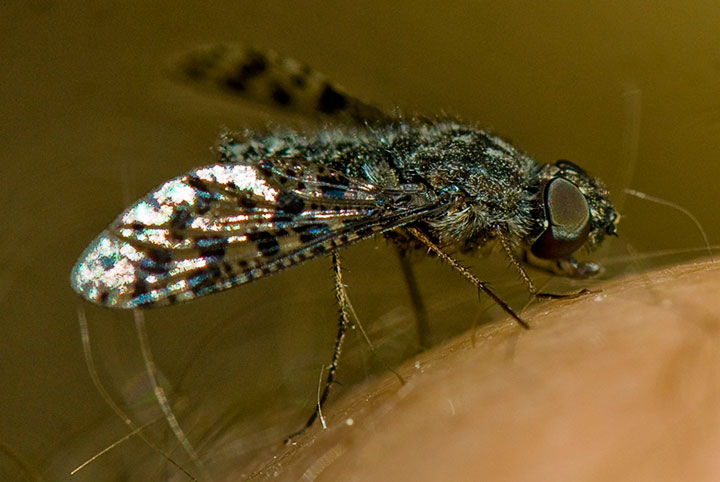 Another species of anthrax flies (Bombyliidae. Anthrax sp, probably A. irroratus).
Another species of anthrax flies (Bombyliidae. Anthrax sp, probably A. irroratus).
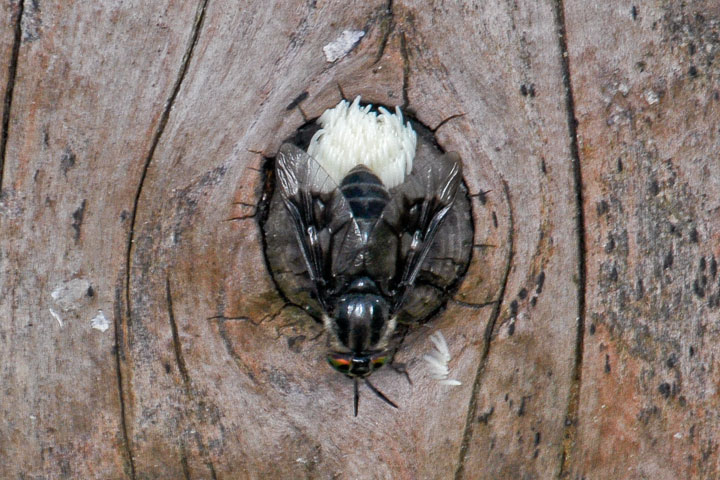 It is early August and this deer fly (Chrysops sp.) is laying eggs.
It is early August and this deer fly (Chrysops sp.) is laying eggs.
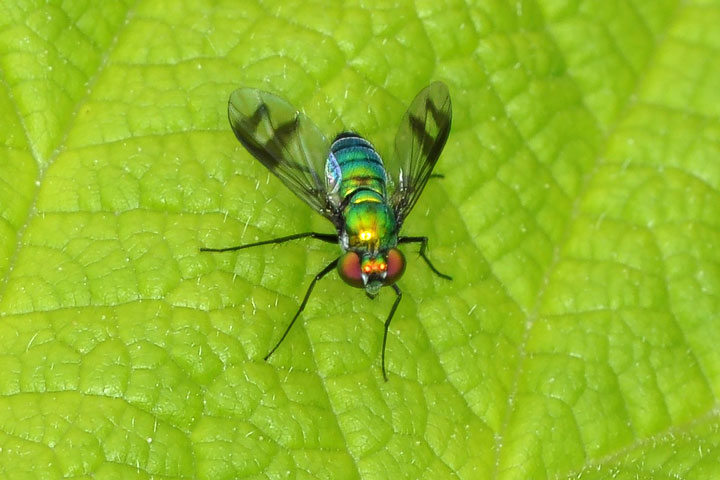 A condylostylid fly is surprisingly colourful with its red eyes, green thorax, and blue–green abdomen. Add to this the patterned wings and it is as visually interesting as a flower. This tiny fly is found in damp woods and along streams where it predates even smaller insects.
A condylostylid fly is surprisingly colourful with its red eyes, green thorax, and blue–green abdomen. Add to this the patterned wings and it is as visually interesting as a flower. This tiny fly is found in damp woods and along streams where it predates even smaller insects.
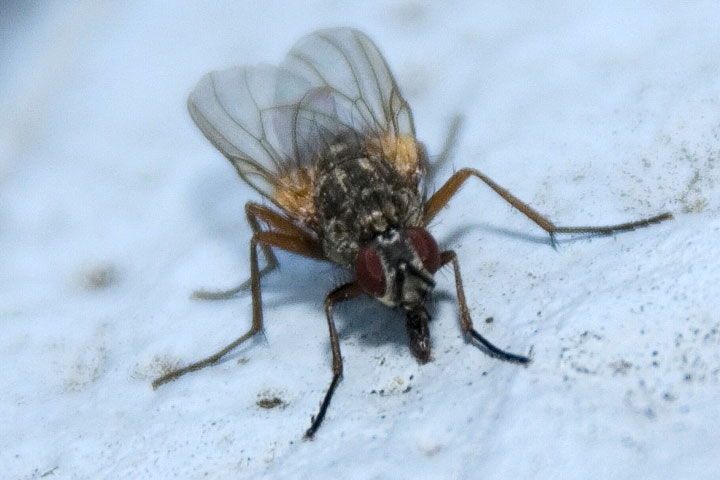 The lesser house fly (also called little housefly) is similar to a housefly, but smaller and holds its wings along its back in a narrower V. The lesser housefly is not usually found in homes, but can be common outdoors in the colder months of spring and fall.
The lesser house fly (also called little housefly) is similar to a housefly, but smaller and holds its wings along its back in a narrower V. The lesser housefly is not usually found in homes, but can be common outdoors in the colder months of spring and fall.
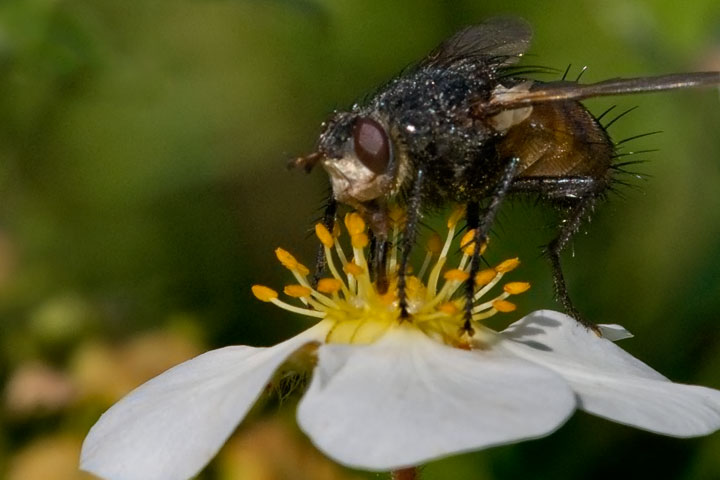 This appears to be a tachinid fly (Tachinidae. Peleteria sp.). The larvae of tachinid flies parasitize other insects.
This appears to be a tachinid fly (Tachinidae. Peleteria sp.). The larvae of tachinid flies parasitize other insects.
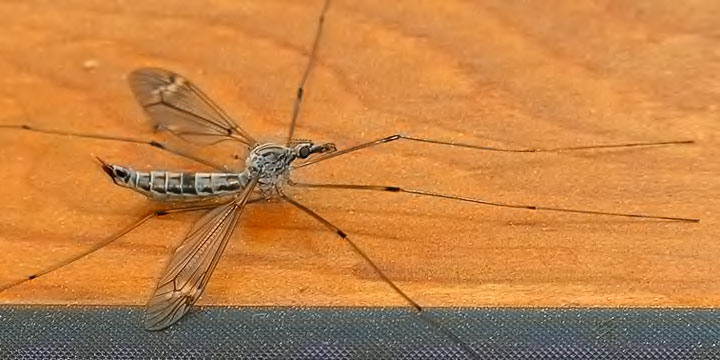 The giant crane fly reminds many of a giant mosquito; yet, it doesn’t bite. To the extent to which crane flies eat anything as adults, it is nectar.
The giant crane fly reminds many of a giant mosquito; yet, it doesn’t bite. To the extent to which crane flies eat anything as adults, it is nectar.
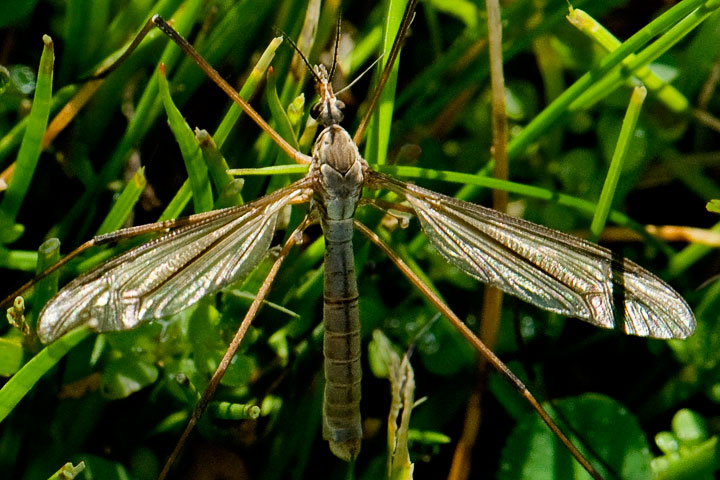 A giant crane fly visits a lawn.
A giant crane fly visits a lawn.
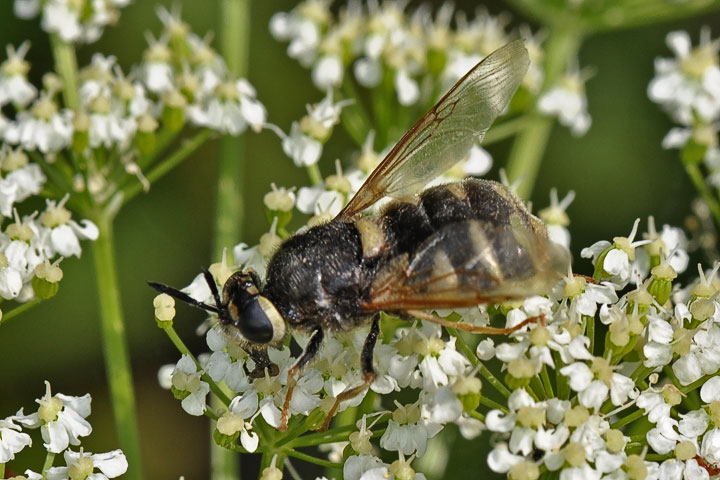 A soldier fly (Family Stratiomyidae) There are many genera and species, but they often mimic the look and behavior of wasps. They often visit flowers; this one is on some cow parsnip blossoms.
A soldier fly (Family Stratiomyidae) There are many genera and species, but they often mimic the look and behavior of wasps. They often visit flowers; this one is on some cow parsnip blossoms.
 Also a soldier fly (Family Stratiomyidae). It is not clear if this is the same species as the one above.
Also a soldier fly (Family Stratiomyidae). It is not clear if this is the same species as the one above.
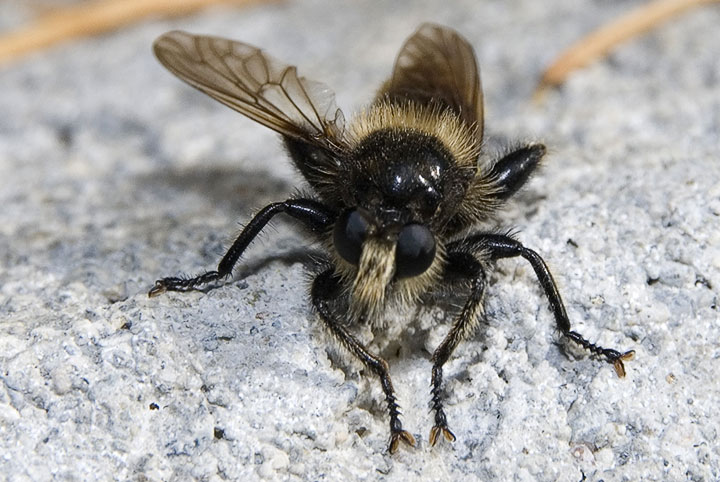 The beeish rober fly (Asilidae. Laphria sp.) is an agile predator. It catches another insect in flight, brings it to the ground, and drains its fluids.
The beeish rober fly (Asilidae. Laphria sp.) is an agile predator. It catches another insect in flight, brings it to the ground, and drains its fluids.
Information from Wikipedia: Crane flies, Hoverflies
![]()